Indonesian Navy
| TNI-AL Tentara Nasional Indonesia-Angkatan Laut (Indonesian Navy) | |
|---|---|
|
TNI-AL insignia | |
| Founded | 10 September 1945 |
| Country |
|
| Allegiance |
|
| Type | Navy |
| Size | 74,000 active duty personnel |
| Nickname(s) | TNI-AL |
| Motto(s) |
Jalesveva Jayamahe (Sanskrit, lit: "Victorious on the Sea") |
| Anniversaries | 10 September 1945 (founded) |
| Fleet |
|
| Engagements |
Battle of Arafura Sea Operation Trikora Indonesia–Malaysia confrontation Incorporation of West Papua into Indonesia Indonesian Invasion of East Timor Insurgency in Aceh |
| Website |
www |
| Commanders | |
| Commander-in-Chief | President Joko Widodo |
| Chief of Staff | Admiral Ade Supandi |
| Vice Chief of Staff | vacant |
| Insignia | |
| Naval Jack |
 |
| Naval Aviation Roundel & Fin Flash |
  |
The Indonesian Navy (Indonesian: Tentara Nasional Indonesia-Angkatan Laut, TNI–AL) was founded on 10 September 1945. Its role is to patrol Indonesia's lengthy coastline, to enforce and patrol the territorial waters and Exclusive Economic Zone (EEZ) of Indonesia, to protect Indonesia's maritime strategic interests, to protect the islands surrounding Indonesia, and to defend against seaborne threats.
The Indonesian Navy is the largest navy in South East Asia based on the number of active personnel and ships. As of 2009, the Indonesian Navy had about 75,000 active personnel and more than 150 vessels in active service. The Indonesian Navy is one of a few navies in the region backed by a substantial domestic defence industry, marine corps, and armed with supersonic missiles and attack submarines.
The Indonesian Navy is headed by a Navy Chief of Staff (Kepala Staf Angkatan Laut - Kasal). The Indonesian Navy is strengthen by two major fleets known as "Armada" which are Komando Armada Barat (Western Fleet Command) located in Tanjung Priok and Komando Armada Timur (Eastern Fleet Command) located in Surabaya with one Military Sealift Command (Komando Lintas Laut Militer). The Navy also heads the Marine Corps.
All commissioned ships of the TNI-AL have the prefix KRI, standing for Kapal Republik Indonesia (Republic of Indonesia Ship).
Mission
According to Law No.34/2004 on the Indonesian National Armed Forces, Article 9, the Navy has the following tasks:
- perform military duties in national defence;
- enforce the law and secure the order in the sea area of national jurisdiction in accordance with national laws and ratified international laws;
- perform diplomatic duties in support of foreign policy set by the government;
- engage other duties relevant for the maintenance and development of naval power;
- support civilian empowerment in sea defence areas.
History
Creation and actions during the revolution
The Indonesian Navy's history began on 10 September 1945, at the outset of the Indonesian National Revolution. The administration of the early Indonesian government established the People's Marine Security Agency (BKR Laut), the predecessor to the modern Indonesian Navy. BKR Laut was initially composed of Indonesian sailors who had served in the ranks of the Royal Netherlands Navy during the Dutch colonial period, and who had fought the Japanese during the years of military occupation, plus active militias who served with the Japanese and ex-Indonesian officers and ratings of the Imperial Japanese Navy. The formation of the Indonesian military organisation known as the People's Security Army (TKR) in 1945, at the height of the National Revolution, helped spur the further existence of the TKR Naval Branch - the Peoples' Security Navy (TLKR), which later became the Republic of Indonesia Navy (ALRI).
As the revolution grew and the Navy began its work, naval bases were established throughout the archipelago. Former ships of the Imperial Japanese Navy handed down to the new republic were acqurired. Simple strength did not discourage the Navy to deploy Sea Traffic Operations in order to spread the news of the proclamation and helping to form and train Republican military forces and militias nationwide. Besides, they also attempted to breach the Dutch naval blockade in order to obtain aid from abroad.
The newly-formed navy confronted the more superior Royal Netherlands Navy in Bali, Sibolga and Cirebon. Cross-sea operations are also able to prepare the armed forces in South Kalimantan, Bali and Sulawesi. Limitations in strength and ability to lead the Navy had to divert the struggle in the countryside, after most boats were sunk and nearly all bases battered by the Dutch and Allied military forces. But the determination to participate again in the sea never subsided. In the hard times during the National Revolution the Navy succeeded in forming the Fleet Forces (CA), Marine Corps (CM), and educational institutions in various places. The formation of these elements mark the presence of aspects for the formation of a modern national navy.
After the revolution
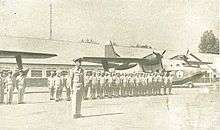
The end of the War of Independence marked the development of the Navy as a modern Navy. In accordance with the results of the Round Table Conference, since 1949, the Navy received a variety of war equipment such as ships - battleships and its various supporting facilities such as Naval Base. This step in the consolidation of the body along with the Navy, revamping the organization and recruitment of personnel through educational institutions before manning naval equipment. During 1949-1959 the Navy managed to enhance the strength and improve its capabilities. In the field of organization the Navy reorganized the Fleet Forces, the Marine Corps - then the Korps Komando Angkatan Laut (KKO-AL - Naval Commando Corps Command), Naval Aviation and a number of Naval Regions as territorial defense command aspects of the sea. Navy combat equipment grew, both from the Dutch and from other various countries.
With the increased strength and the capability, the Navy began refining the strategy, tactics, and techniques of marine operations are directly applied in a variety of military operations in order to deal with separatist movements that have sprung up in the year from 1950 to 1959. In assignment operations PRRI in Sumatra, Permesta , Darul Islam in West Java, and RMS in the Moluccas, the Navy gained lessons in applying the concept of marine operations, amphibious operations, and joint operations with other forces.
At the height of the Cold War
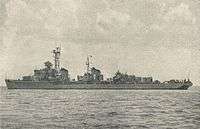
At the time of the country started to recover from the threat of disintegration, in 1959, the Navy launched a program known as Menuju Angkatan Laut yang Jaya. The Navy experienced a significant progress until 1965. This is motivated by the politics of confrontation in order to seize West Irian. As part of the increasing military ties between Indonesia and the Warsaw Pact, various naval combat equipment from Eastern European countries strengthened the Navy and become the dominant force at the time. Some military equipment served in the ranks of the Navy, among others Sverdlov-class cruiser, Skoryy-class destroyer, Riga-class frigate, Whiskey-class submarine (the first such vessels to be used in Southeast Asia), Komar-class missile boat, Ilyushin Il-28 long-range bomber aircraft and the PT-76 Amphibious light tanks and BTR-50 APCs of the Commando Corps, the first of their kind in the region. With such power in the era of the 1960s the Navy was called the largest Navy in Southeast Asia.
The Indonesian government claimed West Irian as part of Indonesia.The Dutch government however, rebuked these claims. The Indonesian Navy started preparing a couple of naval operations for the liberation of West Irian known as Operation Trikora. At the beginning of Trikora, fast-ship torpedo Navy ships have to deal with ships destroyers, frigates and aircraft of the Royal Netherlands Navy. On January 15, 1962 Commodore Yos Sudarso along with RI Macan Tutul sank in the sea battle in the Arafura Sea. This battle is known as the Vlakke Hoek incident. At that time the Navy is preparing to organize Operation Jayawijaya which would be the largest amphibious operation in the history of Indonesian military operations if commenced. No less than 100 warships and 16,000 sailors and Marines prepared in the operation. The deployment of forces forced the Dutch to return to negotiations and reached an agreement to hand over West Irian to Indonesia.
After seizing West Irian, Sukarno by 1963 moved his sights on Malaysia. Indonesia political confrontation against Neocolonialism and Imperialism (Nekolim) continued in Operation Dwikora to oppose the formation of Malaysia. Although elements of the Armed Forces of Indonesia have been prepared in the operation, the operations were limited to the infiltration operation along the Borneo frontier. Soldiers from the marines were involved in the operations which targeted both the Malaysian states of Sabah and Sarawak.
1965 onwards
_underway_in_the_Pacific_Ocean%2C_circa_in_1971_(K-88514).jpg)
Operation Dwikora was discontinued in 1965 along with a succession of governments in Indonesia after an attempted coup d'etat took place in Jakarta, which were organized by the Indonesian Communist Party. Since 1966, the Navy experienced a new chapter in its history as the military integration efforts. With the integration of the armed forces organizationally and operationally been able to keep up on the implementation of tasks in the field of defense and security so doctrinally, the direction of development of the power and capabilities of each branch to be concentrated. The operations were prominent during the period of the 1970s was Operation Seroja in the framework of the integration of East Timor to Indonesia. Navy played an active role in the operation of landings, a joint ground operation, and transporting troops by sea.
Starting the 1980s the Navy began to modernize combat equipment. Ships made made in Eastern Europe that has been the core strength of the Navy in the era of the 1960s and 1970s is considered no longer meeting requirement of the Navy. The worsening relations between Indonesia and the Soviet Union after the government of President Sukarno resulted a cessation of military cooperation between the two countries and the Warsar Pact. Therefore, the Navy switched adopting Western technology to modernize the power and ability to buy warships, logistics vessels and other major combat equipment from various countries. Included among those commissioned during the Suharto presidency were Fatahillah-class corvette and Van Speijk-class frigate from the Netherlands, Type 209 submarine from West Germany, Fast Patrol boat from South Korea, and the GAF Nomad patrol aircraft from Australia. In 1993 the Navy also received 39 ships from the former Volksmarine (East German Navy), including 13 Parchim Class corvettes, the Frosch-class landing ship tank (LST), and 9 Kondor II-class minessweepers.

At the same time the Navy began to develop a non-combat military operations in the form of humanitarian service Surya Bhaskara Jaya in various remote areas in Indonesia that can only be reached by sea. The core of the operating activities of health services, construction and rehabilitation of public facilities and various counseling in health, law, and civil defense. This event is held regularly every year until now. A number of countries also participated in these activities, among others, Singapore, Australia and the United States. The navy also seeks promoting the development of the maritime sector long before the Department of Marine formed, especially those related to aspects of defense and security at sea. The actual activities undertaken today by the Navy is establishing marine development assessment bodies together with the government and private sectors in some areas, coastal village pilot program are summarized in Coastal Rural Development (Bindesir), and the National Potential Development Program for Maritime Defense (Binpotnaskuatmar). In order to inflame the marine life of the nation, the Navy held an international scale maritime event Arung Samudera 1995. The navy is also a major supporter of the proclaimed Year of Maritime 1996 and the Bunaken Declaration of 1998, which is a manifestation of marine development in Indonesia.
Organisation
The navy comprises the following:
- Headquarters Staff (HQ, Jakarta) under the overall command of the Navy Chief of Staff,
- Two Fleet Commands :
- Several Naval Main Bases and Naval Bases throughout Indonesia. Apart from the major bases at Surabaya and Jakarta, forward operating bases exist at Kupang, West Timor and Tahuna, Sulawesi.
- Marine Corps, with two Marine Forces and an independent Marine Brigade
- Naval Aviation Center,
- Military Sealift Command – coordinates the navy's logistical support systems
- Indonesian Naval Academy
- Naval Education and Training Command
- Women's Naval Service
- Naval Police Command
Plans exist to have a single HQ at Surabaya, with commands at Riau (West), Papua (East), and Makassar (Central).[1] JDW reported on 12 November 2003 that Admiral Bernard Kent Sondakh, the Chief of Naval Staff, was advocating a plan to merge the two fleets to form a single Main Operations and Administration Defence Command, to be headed by a three-star officer and headquartered at Surabaya.[2]
Naval bases
Headquarter converted into sequential numbering of Lantamal I to XI according to the location from west to east on August 1, 2006 in line with the inauguration of the Naval Base (Lanal) Teluk Bayur in Padang, West Sumatra into Main Naval Base (Lantamal) II. In 2015, three Naval Base (Lanal) were upgraded to Main Naval Base (Lantamal) with the numbering of XII, XIII and XIV. The navy strength are spread across several Navy Main Base (Lantamal) under two main fleet command, namely:
- Western Fleet Command ("KOARMABAR")
- Main Naval Base I (Lantamal I) in Belawan, oversees naval bases covering Sabang, Dumai, Lhokseumawe, Tanjung Balai and Simeulue. The main naval base also oversee one Naval Air Station (Lanudal) Sabang and two facilities maintenance and repair (Fasharkan) in Sabang and Belawan. The main naval base is scheduled to be moved to Lhokseumawe in Aceh.
- Main Naval Base II (Lantamal II) in Padang, oversees naval bases covering Sibolga, Nias, Mentawai (planned), and Bengkulu.
- Main Naval Base III (Lantamal III) in Jakarta, oversees six naval bases covering Palembang, Cirebon, Lampung, Banten, Bandung, and Bangka-Belitung. Moreover, it has a maintenance and repair facility in Pondok Rowing, Jakarta. These maintenance and repair facility now has the ability to make small patrol boat with a size of 28–35 meters. Furthermore, the main naval base also oversees Naval Air Station Pondok Cabe.
- Main Naval Base IV (Lantamal IV) in Tanjung Pinang oversees naval bases covering Batam, Tarempa, Ranai, Tanjung Balai Karimun, and Dabo Singkep. Lantamal Tanjung Pinang has a maintenance and repair facility or Fasharkan in Mentigi (Fasharkan Mentigi) that has the ability to make the patrol boat (KAL) 12, 28 and 35 meters. In addition, it has 2 Naval Air Station (Lanudal) in Matak, Natuna Islands, and in Tanjungpinang / Kijang.
- Main Naval Base XII (Lantamal XII) in Pontianak oversees naval bases covering Pangkalan Bun, Ketapang and Sambas.
- Eastern Fleet Command: ("KOARMATIM")
- Main Naval Base V (Lantamal V) in Surabaya oversees seven naval bases and one Naval Air Station, including Tegal, Cilacap, Semarang, Yogyakarta, Malang, Banyuwangi, Denpasar and Batuporon.
- Main Naval Base VI (Lantamal VI) in Makassar, in charge of naval bases in Kendari, Palu, Balikpapan, Kotabaru and Banjarmasin.
- Main Naval Base VII (Lantamal VII) in Kupang, East Nusa Tenggara, in charge of naval bases in Mataram, Maumere, Kupang, Tual and Aru. In addition, it has 1 Naval Air Station (Lanudal) in Kupang.
- Main Naval Base VIII (Lantamal VIII) in Manado, North Sulawesi, in charge of naval bases Tarakan, Nunukan, Tahuna, Toli-Toli and Gorontalo. In addition, it has 1 Naval Air Station (Lanudal) in Manado.
- Main Naval Base IX (Lantamal IX) in Ambon oversees naval bases in Ternate, Saumlaki, Morotai, Tual and Ambon.
- Main Naval Base X (Lantamal X) in Jayapura, oversees Biak Naval Base and Biak Naval Air Station .
- Main Naval Base XI (Lantamal XI) in Merauke, Papua oversees naval bases in Timika and Aru Islands. In addition, it has 1 Naval Air Station (Lanudal) in Aru Islands.
- Main Naval Base XIII (Lantamal XIII) in Tarakan, North Kalimantan
- Main Naval Base XIV (Lantamal XIV) in Sorong, West Papua in charge of the maintenance and repair facility in Manokwari which is capable of producing small patrol boats of length 12 and 28 meters.
Future Fleet Command Territorial: Indonesia will create a new fleet command, a middle fleet command in Makassar - Celebes (Sulawesi) and also move its eastern fleet to Sorong - Papua. Surabaya Fleet Command will become a central fleet command (High Command). [3]
Main Command
Operational Command
- Eastern Fleet
- Western Fleet
- Military Sealift Command (Komando Lintas Laut Militer)
Combat Command

Education Command
- Naval Doctrine, Education, and Training Development Command (Kodiklatal)
- Naval Staff College (Seskoal)
- Indonesian Naval Academy Surabaya (Akademi Angkatan Laut AAL)
Central Executive Body
- Naval Military Police Command (Puspom-AL)
- Naval Aviation Command (Pusat Penerbangan Angkatan Laut)
- Naval Technology College (Sekolah Tinggi Teknologi Angkatan Laut)
- Naval Hydrography and Oceanography Center (Pushidrosal)
Corps
- Fleet Forces Corps - Personnel wear black berets in their dress uniforms.
- Nautical Corps
- Navigation Corps
- Communication Corps
- Telegraphic Corps
- Armaments Corps
- Surface Weapon Systems
- Underwater Armaments
- Mechanical Engineering Corps
- Mechanical Engineers
- Diesel Mechanical Engineers
- Structural Engineering Corps
- General Construction Engineering
- Transportation Corps
- Electronics Corps
- Computer Data Processing Corps
- Electricity Corps
- Supply and Administration Corps
- Finance Corps
- Administration Corps
- Housekeeping Corps
- Supply Corps
- Marine Corps - Personnel wear purple berets
- Marine Infantry
- Marine Artillery
- Marine Armored Cavalry
- Engineers
- Communications
- Transport, Supplies and Equipment
- Women's Naval Service Corps
- Medical Corps Department
- General Nursing Corps
- Pharmacy Corps
- Paramedic Assistance Corps
- Dental Corps
- Special Corps
- Physical Fitness Corps
- Naval Military Police Corps - Personnel wear light blue berets pushed to the left
- Band Service Corps
Ships
Naval Aviation
.jpg)
The Naval Aviation (Indonesian: Pusat Penerbangan TNI Angkatan Laut - Puspenerbal) is one part of the Navy's Central Implementing Body led by a First Vice Admiral. Puspenerbal as the center of guidance to the Navy's aviation aviation units in the field of personnel as well as the readiness of air elements. Puspenerbal is not just a combat unit, but also participates in various Marine Corps operation tasks as well as providing logistics and personnel tactical transport facilities for marine and airbase systems. In carrying out these tasks, Puspenerbal carries out flight functions which include: Air surveillance, waterproof anti-submarine, anti-submarine, lander landing landing, fast logistics support, maritime patrol, marine combat operations, and the provision of material coaching functions. This unit is in charge of supporting naval operations, both for combat operations, SAR operations and humanitarian relief operations. Marine security to monitor the movement of foreign ships, especially in the archipelagic sea lanes of Indonesia, environmental protection from the pollution of dangerous materials, the prevention of smuggling and theft of marine wealth is also an important mission carried by Dispenerbal, in cooperation with other air force elements such as TNI-AU and Police. One of the most famous acts of Navy aircraft recently was when they were involved in evacuating victims of the earthquake in Jogjakarta.
Ground forces
Marine Corps

The Indonesian Marine Corps (Indonesian: Korps Marinir) officially known as KORMAR or simply "Marinir", Tentara Nasional Indonesia – Angkatan Laut, ("KORMAR", TNI-AL); officially translated as: Marine Corps, Indonesian Navy[4] is the currently integral part of the Indonesian Navy (TNI-AL) and sized at the military corps level unit as the Naval Infantry and main amphibious warfare force of Indonesia. There are future plans to expand the Indonesian Marine Corps to become an independent, uniformed force. It is commanded by a two star marine general. It has two divisions, which are:
- Pasukan Marinir I / "PASMAR I" (Marine Force I) based in Jakarta for operations in the western fleet of Indonesia
- Pasukan Marinir II / "PASMAR II" (Marine Force II) based in Surabaya for operations in the eastern fleet of Indonesia.
The two marine divisions (PASMAR I and II) are each led by a one star admiral (Brigadier General/Commodore).
Special Forces
KOPASKA
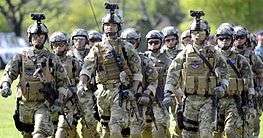
Formed in 31 March 1962, Komando Pasukan Katak or KOPASKA is considered as one of Indonesia's most elite special forces after the Kopassus of the army. The unit gained notoriety after managed to free the MV Sinar Kudus who was hijacked by Somali pirates on 16 March 2011 without resulting any casualties.[5] The Unit's main duties are underwater demolition (raiding enemy ships and bases), destroying main underwater installations, reconnaissance, prisoner snatches, preparing beaches for larger naval amphibious operations, and counter-terrorism. In peacetime the unit deploys a seven-person team to serve as security personnel for VIPs. Primary among these duties are the escort and personal security of the Indonesian president and vice-president.
Taifib
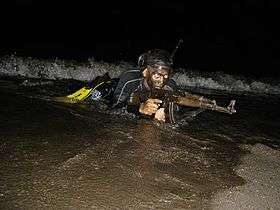
Batalion Intai Amfibi or Taifib is the Marine Corps' Amphibious Reconnaissance Battalion, which also has capability as para-commando. They were officially formed on 18 March 1961 as marine commandos. Set at battalion strength, "Taifib" is the elite amphibious reconnaissance unit of the Indonesian Marine Corps. It was first used in the Irian Jaya (Papua) during Operation Trikora in April 1962. Starting from November 1971 it was called "Batalyon Intai Amphibi" ("Yon Taifib") or Amphibious Recon Battalion. To become a Yontaifib troop, a candidate is selected from the Marine Corps who has already fulfilled the thorough mental and physical requirements, and who at least has actively served the corps for two years. The certification of amphibious reconnaissance is so difficult that the passing rate of these candidates in each class is only ten percent.
Denjaka
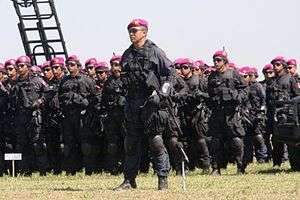
Detasemen Jala Mangkara or Denjaka' is the special operations and counter-terrorism forces of the Indonesian Navy. This is a combined detachment formed from selected personnel of the Navy's Underwater Special Unit (Kopaska) and the Marine Corps' Amphibious Reconnaissance Battalion (KIPAM aka Yontaifib). The unit was formed in 1984 by the Chief of the Indonesian Armed Forces to counter maritime strategic threats including terrorism and sabotage. Despite the specific reason for its formation, as in the case of any other special operations forces around the world, the detachment is also fully trained in conducting reconnaissance, unconventional warfare, and clandestine behind-enemy-lines operations. Denjaka's primary task is to develop anti-terrorism, anti-sabotage and other clandestine operations capabilities in support of maritime counter-terrorism, counter-sabotage and other special operations as directed by the chief of the armed forces.
Ongoing projects
The Indonesian Navy plans to have 151 vessels (minimum), 220 vessels (standard), or 274 vessels (ideal), for which it has a blueprint up to 2024.[6]
In April 2011, PT PAL, in co-operation with Dutch Naval Shipbuilding, started designing a new light frigate for ASW purposes. It will be the largest warship built by PT PAL.[7] The first steel cutting ceremony was held on January 2014 and order for two PKR ships is confirmed. Equipped with VL Mica missiles and Oerlikon Millennium CIWS, these ships are also usable for air defence purposes.
At the same time, Indonesian Navy has accepted a grant of two used patrol boats equipped with guided missiles made in Britain from Brunei, which has replaced them with newer vessels.[8]
As of June 2011 Indonesia was in the process of choosing submarines from one of three countries: France's Scorpène class, Germany's Type 209 and the South Korean Chang Bogo class Type 209.[9] In December 2011, a contract to build three submarines was signed by Indonesia and Daewoo Shipbuilding & Marine Engineering (DSME). Two submarines will be built in South Korea in co-operation with Indonesian state-owned shipbuilder PT PAL, while the third will be built at PT Pal's facilities. The contract was worth $1.07 billion and construction was planned to start in January 2012, with delivery expected in 2015 and 2016. The submarines will weigh 1,400 tons and be 61.3 metres (201 ft 1 in) long, with a crew of up to 40 and with 8 weapons tubes for torpedoes and other weapons. The procurement is an effort to keep pace with other countries in the region.[10][11] The submarines will be based at Palu naval base in Central Sulawesi which is currently under construction.[12]
In January 2012, the Navy confirmed an order for the 24 guided-missile fast boats to be deployed in the shallow waters in the western part of Indonesia and in North Sulawesi which are geographically dotted by small islands and divided by straits. Indonesia now has 8 KCR-40s (Kapal Cepat Rudal 40-meter, literally meaning 40-meters Fast Missile Boat), all in full commission by 20 December 2013.[13] These vessels will be 45 percent locally sourced and are to be designed and built locally. They will cost Rp 73 billion ($7.98 million) each and have a top speed of 30 knots. They will carry Chinese C-705 anti-ship missiles with a range up to 120 kilometres (75 mi), a 6-barreled 30-millimeter close-in weapons system and two 20-millimeters guns.[14][15][16] Indonesia has also decided to restart procurement of the Trimaran, Klewang class FMPV(Fast missile patrol vessel), with an initial order of four boats.[17]
The Indonesian Navy is also preparing to acquire three new British built corvettes,[18] classified as Bung Tomo-class corvette, after its leading ship, KRI Bung Tomo (357). They were built for Brunei but rejected for not meeting their requirements, allowing Indonesia to buy them cheaply.
In December 2013, the Indonesian Ministry of Defence stated that the Indonesian Navy planned to buy several used Kilo-class submarines still in commission with the Russian Navy.[19] A team consisting of Indonesian Navy experts was to be sent to Russia to inspect the condition of these future submarines.[20] In March 2014 the procurement was cancelled.[21]
Integrated Maritime Surveillance Systems
With various coastal radars, Indonesia has one of the world's longest Integrated Maritime Surveillance Systems (IMSS). The network covers more than 1,205 kilometres (749 mi) of coastline in the Straits of Malacca and about 1,285 kilometres (798 mi) of coastline in the Sulawesi Sea.[22]
Rank Structure
In the navy, as well as in other armed forces branches in Indonesia, the rank consists of officer known as in Indonesian: "Perwira", NCO "Bintara" and enlisted "Tamtama".
| Ranks and Insignias - Indonesian Navy | ||||||||||||||||||||||||||||||||||||||||||||||||||||||||||||||||||||||||||||||||||||||||||||||||||||||||||||||||||||||||||||||||||||||||||||||||||||||||||||||||||||||||||||||||||||||||||||||||||||||||||||||||||||||||||||||||||||||||||||||||||||||||||||||||||||||||||||||||||||||||||||||||||||||||
|---|---|---|---|---|---|---|---|---|---|---|---|---|---|---|---|---|---|---|---|---|---|---|---|---|---|---|---|---|---|---|---|---|---|---|---|---|---|---|---|---|---|---|---|---|---|---|---|---|---|---|---|---|---|---|---|---|---|---|---|---|---|---|---|---|---|---|---|---|---|---|---|---|---|---|---|---|---|---|---|---|---|---|---|---|---|---|---|---|---|---|---|---|---|---|---|---|---|---|---|---|---|---|---|---|---|---|---|---|---|---|---|---|---|---|---|---|---|---|---|---|---|---|---|---|---|---|---|---|---|---|---|---|---|---|---|---|---|---|---|---|---|---|---|---|---|---|---|---|---|---|---|---|---|---|---|---|---|---|---|---|---|---|---|---|---|---|---|---|---|---|---|---|---|---|---|---|---|---|---|---|---|---|---|---|---|---|---|---|---|---|---|---|---|---|---|---|---|---|---|---|---|---|---|---|---|---|---|---|---|---|---|---|---|---|---|---|---|---|---|---|---|---|---|---|---|---|---|---|---|---|---|---|---|---|---|---|---|---|---|---|---|---|---|---|---|---|---|---|---|---|---|---|---|---|---|---|---|---|---|---|---|---|---|---|---|---|---|---|---|---|---|---|---|---|---|---|---|---|---|---|---|---|---|---|---|---|---|---|---|---|---|---|---|---|---|---|
Officers[n 1]
Enlisted ratings[n 1]
| ||||||||||||||||||||||||||||||||||||||||||||||||||||||||||||||||||||||||||||||||||||||||||||||||||||||||||||||||||||||||||||||||||||||||||||||||||||||||||||||||||||||||||||||||||||||||||||||||||||||||||||||||||||||||||||||||||||||||||||||||||||||||||||||||||||||||||||||||||||||||||||||||||||||||
Notes
See also
References
- ↑ IISS Military Balance 2007, p.353
- ↑ JDW 19 November 2003, p.16-17
- ↑ http://news.detik.com/berita/2845482/akan-ada-3-komando-armada-tni-al-pangarmatim-jadi-armada-pusat-ri
- ↑ http://www.marinir.mil.id Archived 29 April 2015 at the Wayback Machine.
- ↑ Kisah Operasi Pasukan Katak di MV Sinar Kudus
- ↑ "Indonesia Targetkan Miliki 154 Kapal Perang Hingga 2024". JakartaGreater. Retrieved 25 May 2016.
- ↑ "Indonesia looks to build its own warships". The Jakarta Post. 23 March 2011. Retrieved 22 September 2013.
- ↑ "TNI considering two patrol boats from Brunei". ANTARA News. 4 April 2011. Retrieved 22 September 2013.
- ↑ "Navy shopping for new submarines". The Jakarta Post. 6 June 2011. Retrieved 22 September 2013.
- ↑ "December 22, 2011 – RI orders 3 submarines worth $1b in regional ‘catch-up’". Thejakartapost.com. Retrieved 7 November 2013.
- ↑ "Navy Opens New Base Prepared for Submarines". Defense-studies.blogspot.com. 7 April 2013.
- ↑ Rahmat, Ridzwan (30 July 2015). "Indonesian government calls for urgent completion of submarine basing facilities". IHS Jane's Navy International. Retrieved 2 August 2015.
- ↑ "Menhan Resmikan 1 KRI dan 2 KAL Buatan Batam". batamtoday.com.
- ↑ "Navy to procure 24 fast boats to patrol shallow waters". Thejakartapost.com. Retrieved 5 January 2012.
- ↑ "Indonesia: Defense Minister Launches "KRI Clurit" >>". Naval Today. 26 April 2011. Retrieved 22 September 2013.
- ↑ "Bank Mandiri finances missile boats". The Jakarta Post. 25 April 2011. Retrieved 22 September 2013.
- ↑ Ridzwan Rahmat, Jakarta – IHS Jane's Defence Weekly (14 August 2014). "Indonesia confirms acquisition of four Klewang-class stealth patrol ships – IHS Jane's 360". Janes.com. Retrieved 28 June 2015.
- ↑ "Purchase Confirmed, Navy Waits for Three New Ships". en.tempo.co.
- ↑ "Indonesia borong kapal selam dari Rusia". merdeka.com.
- ↑ "Butuh Kapal Selam, TNI Kirim Tim ke Rusia". tempo.co.
- ↑ NurW. "DEFENSE STUDIES". Retrieved 24 December 2014.
- ↑ "News". Embassyofindonesia.org. 1 July 2010. Retrieved 7 November 2013.
External links
- Official website
- Indonesian Navy ships and equipment (Navy Recognition)
- ALRI – Navy of the Republic of Indonesia @ Globalsecurity.com
- Indonesian Military Blog




















.svg.png)